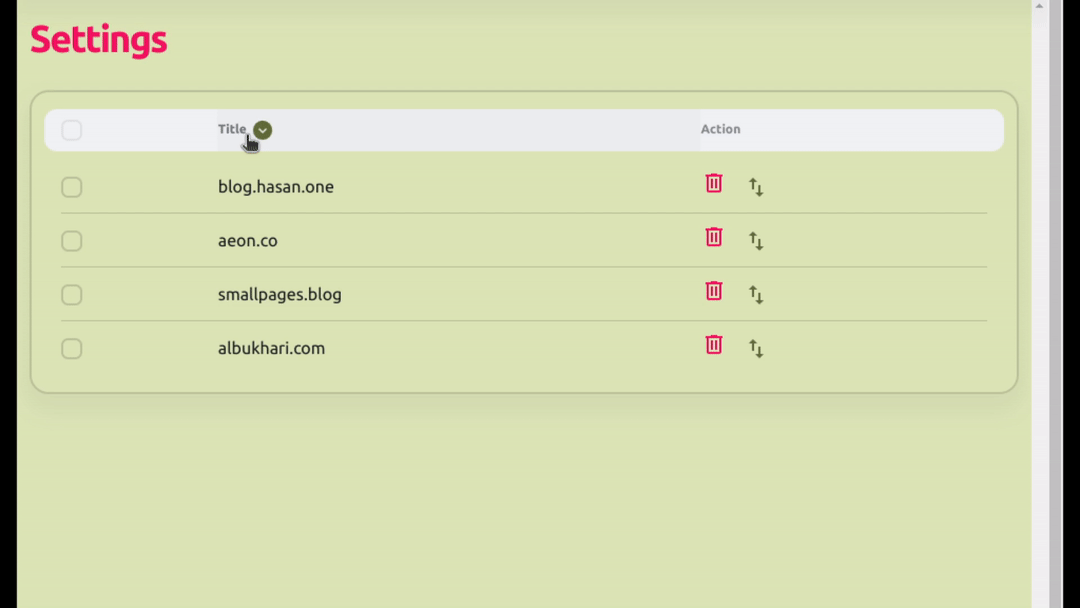How to sort table in NextUI
A useful example on how to utilize the sorting functionality that NextUI tables have.

Overview

- Create a table following any of the examples from the NextUI docs.
- Create a state to hold your data and the
sortDescriptorobject that will be used to help the sorter function. - Create a function that will be used to sort your data.
- Inside the
Table.Bodytag, add the following props:onSortChange,sortDescriptor
Details
NextUI tables can be sorted by column. The docs contain one example and it uses useAsyncList to load and sort some async data (ex: data coming from network). But what if you are using other tools to manage async data (ex: React Query)? This post is for you.
In my case, React Query was managing the fetching/caching of my data. But it is all the same even if you are using vanilla useEffect.
First, we create a state to store our data:
const [arr, setArr] = useState({
items: [],
sortDescriptor: { direction: "descending", column: "title" },
});
The state will have specific type since we want to stay close to the NextUI implementation. Hence we will store the data inside items prop and we will have a sortDescriptor prop that holds details about the sorting derection and which column are we sorting.
If you are recieving the data from a parent component, then go ahead and place the data inside the items array (your data must be an array). If you need to process your data first, you can do that inside a useEffect function:
useEffect(() => {
let temp = [];
for (const [key, value] of Object.entries(data.results)) {
temp.push(...value);
}
setArr({ ...arr, items: [...temp] });
}, [data.results]);
Now we create a function to sort our data. This is vanilla js array sorting:
function sortArr() {
const { items, sortDescriptor } = arr;
items.sort((a, b) => {
let first = a[sortDescriptor.column];
let second = b[sortDescriptor.column];
let cmp = collator.compare(first, second);
if (sortDescriptor.direction === "descending") {
cmp *= -1;
}
return cmp;
});
setArr({
items,
sortDescriptor:
sortDescriptor.direction === "ascending"
? { direction: "descending", column: "title" }
: { direction: "ascending", column: "title" },
});
}
The only addition to the vanilla js array sorting function is using the sortDescriptor.direction flag to determine if we should sort ascending or descending. This is useful since we will toggle the direction with each click on the column header (1. click -> sort asc, 2. click -> sort desc).
Finally we create a NextUI table and enable sorting as follows:
<Table
aria-label="Example static collection table with multiple selection"
css=
onSortChange={sortArr}
sortDescriptor={arr.sortDescriptor}
>
<Table.Header>
<Table.Column key="title" allowsSorting>
Title
</Table.Column>
<Table.Column>Action</Table.Column>
</Table.Header>
<Table.Body>
{arr.items &&
arr.items.map((feed, key) => {
return (
<Table.Row key={key + 1}>
<Table.Cell>{feed.title}</Table.Cell>
<Table.Cell>
<Button
onPress={() => mutation.mutate(feed.rowid)}
css=
>
<Delete />
</Button>
</Table.Cell>
</Table.Row>
);
})}
</Table.Body>
</Table>
The important things to note here are: 1. We are rendering arr.items inside the Table.Body which makes sense since this is where we stored our data. 2. The Table.Column has a key="title" which is useful to identify the column by which we are sorting. 3. the Table has onSortChange = {sortArr} which calls our sort array whenever a sortChange event fires. The Table also has sortDescriptor={arr.sortDescriptor} which passes our sortDescriptor which we store in the state. This is important since we toggle this descriptor inside our sort array.
Final notes
The onSortChange = {sortArr} will pass a prop containing an object similar to sortDescriptor to out sort function. I have not figured out how best to use this but it is something I wanted to mention.